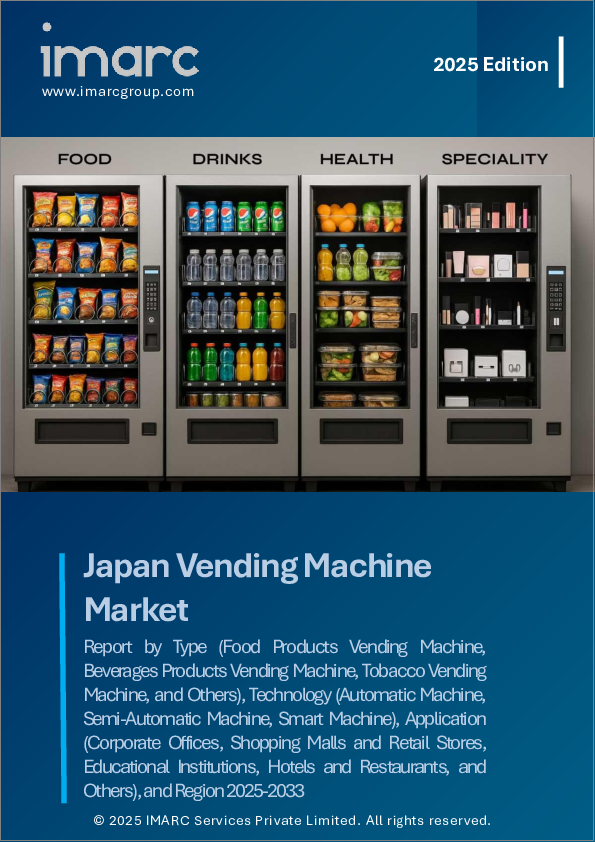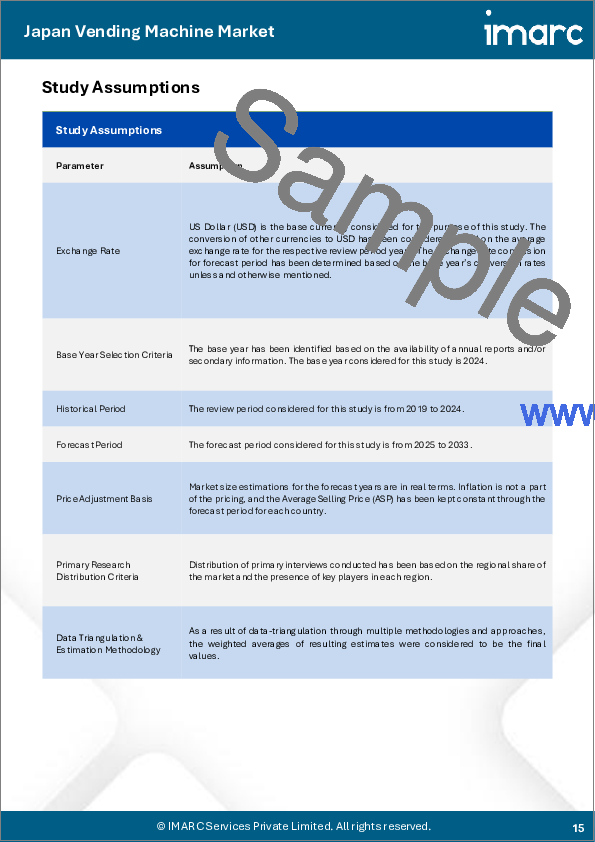|
|
市場調査レポート
商品コード
1729325
日本の自動販売機市場レポート:タイプ、技術、用途、地域別、2025年~2033年Japan Vending Machine Market Report by Type, Technology, Application, and Region 2025-2033 |
||||||
カスタマイズ可能
|
|||||||
| 日本の自動販売機市場レポート:タイプ、技術、用途、地域別、2025年~2033年 |
|
出版日: 2025年05月01日
発行: IMARC
ページ情報: 英文 122 Pages
納期: 5~7営業日
|
全表示
- 概要
- 目次
日本の自動販売機の市場規模は2024年に12億6,600万米ドルに達しました。今後、IMARC Groupは、市場は2033年までに19億600万米ドルに達し、2025-2033年の成長率(CAGR)は4.7%になると予測しています。キャッシュレス決済オプションの採用が増加していること、自動販売機が従来の商品だけでなく、生鮮食品や化粧品など幅広い商品を提供するように拡大していること、ユーザーエクスペリエンスと業務効率を高めるためにスマート技術を統合していることなどが、市場の成長を促進する主な要因となっています。
本レポートで扱う主な質問
- 日本の自動販売機市場はこれまでどのように推移し、今後どのように推移するのか?
- COVID-19が日本の自動販売機市場に与えた影響は?
- 日本の自動販売機市場のタイプ別区分は?
- 日本の自動販売機市場の技術別区分は?
- 日本の自動販売機市場の用途別区分は?
- 日本の自動販売機市場のバリューチェーンにおける様々なステージとは?
- 日本の自動販売機の主な促進要因と課題は何か?
- 日本の自動販売機市場の構造と主要プレーヤーは?
- 日本の自動販売機市場における競合の程度は?
目次
第1章 序文
第2章 調査範囲と調査手法
- 調査の目的
- ステークホルダー
- データソース
- 市場推定
- 調査手法
第3章 エグゼクティブサマリー
第4章 日本の自動販売機市場:イントロダクション
- 概要
- 市場力学
- 業界動向
- 競合情報
第5章 日本の自動販売機市場情勢
- 過去および現在の市場動向(2019~2024年)
- 市場予測(2025~2033年)
第6章 日本の自動販売機市場:タイプ別内訳
- 食品自動販売機
- 飲料製品自動販売機
- タバコ自動販売機
- その他
第7章 日本の自動販売機市場:技術別内訳
- 自動機械
- 半自動機
- スマートマシン
第8章 日本の自動販売機市場:用途別内訳
- 企業オフィス
- ショッピングモールと小売店
- 教育機関
- ホテルとレストラン
- その他
第9章 日本の自動販売機市場:競合情勢
- 概要
- 市場構造
- 市場企業のポジショニング
- 主要成功戦略
- 競合ダッシュボード
- 企業評価象限
第10章 主要企業のプロファイル
第11章 日本の自動販売機市場:業界分析
- 促進要因、抑制要因、機会
- ポーターのファイブフォース分析
- バリューチェーン分析
第12章 付録
Japan vending machine market size reached USD 1,266 Million in 2024. Looking forward, IMARC Group expects the market to reach USD 1,906 Million by 2033, exhibiting a growth rate (CAGR) of 4.7% during 2025-2033. The increasing adoption of cashless payment options, the expansion of vending machines beyond traditional products to offer a wider range of goods such as fresh food and cosmetics, and the integration of smart technology for enhanced user experience and operational efficiency are some of the key factors driving the growth of the market.
Japan Vending Machine Market Analysis:
- Major Market Drivers: One of the significant factors propelling the growth of the market is the convenience offered by vending machines, as they offer 24*7 access to a wide range of products, eliminating the need for traditional retail store hours. In addition to this, cultural acceptance of convenience shopping through automated retail solutions is also contributing to the market growth.
- Key Market Trends: The integration of advanced technologies to improve the capabilities and functionalities of vending machines is one of the prominent trends catalyzing the market growth. Furthermore, the integration of touch screens and interactive displays that provide seamless user experience is also contributing to the market growth.
- Challenges and Opportunities: The Japan vending machine market faces numerous challenges, such as increasing competition, especially from online retailers, and the need to adapt to changing consumer preferences and demands for healthier options. However, opportunities include innovation, such as incorporating cashless payment options, offering customizable product selections, and expanding into new markets or locations.
Japan Vending Machine Market Trends:
Increasing Preference for On-The-Go Snacks
Growing demand for on-the-go snacks, food, and drinks due to the changing lifestyle of the urban populations is primarily driving the growth of the market. For instance, an increase in demand for convenient on-the-go food options was justified by a 10.22% growth in fast-food orders in 2022. Moreover, with approximately 3.8 million international visitors in 2022, the preference toward on-the-go snacking options was higher, leading to the expansion of vending machines offering ready-to-eat snacks and beverages in Japan. Moreover, in Japan, there is one vending machine for every 23 people, the highest ratio of vending machines per person in the world. In addition to this, in June 2023, a lineup of vending machines was installed on the Meitetsu Nagoya Railway Line at Meitetsu Nagoya Station. The vending machines sell popular products from Kinokuniya, Loft, and Seijo Ishii, three of the country's most well-known chains. Such an increasing establishments of vending machines in Japan is projected to propel the Japan vending machine market's price in the coming years.
Technological Advancements
The integration of advanced technologies has transformed traditional vending machines into smart, interactive devices. Cashless payment systems, such as contactless cards, mobile wallets, and digital currencies, offer convenience and security to consumers. Moreover, with the increasing demand for contactless payments, numerous vending machine manufacturers are introducing new and improved machines, which is positively impacting the Japanese vending machine market. For instance, in September 2023, Barista launched an automated coffee vending machine called the Root C at Tokyo's Shimbashi Station. The machine lets users order via the app and specify pickup time slots, allowing customers to have their drinks ready in advance. Root C offers 16 different drinks, including hot and iced varieties, all made with specialty beans. The app includes a seven-item questionnaire designed by baristas to help customers decide, asking about what aromas they like and what other drinks they enjoy.
Urbanization and Smart City Development
The elevating levels of urbanization in the country are creating a high footfall environment conducive to vending machine deployment, maximizing potential sales opportunities. For instance, in the past decade, Japan's degree of urbanization has leveled off at around 91.9%. Furthermore, the government authorities of Japan are increasingly focusing on developing smart cities and investing in the development of technologically advanced airports and railways, comprising of smart vending machines, which is creating a positive outlook for the overall market. For instance, Society 5.0, also known as the Super Smart Society, is a concept for a future society created through a new industrial revolution introduced by the Japanese government in 2016. The plan proposes integrating smart devices and technologies, such as AI-integrated vending machines, more effectively into society. Such innovations are anticipated to bolster the Japan vending machine market size in the coming years.
Japan Vending Machine Market Segmentation:
Breakup by Type:
- Food Products Vending Machine
- Beverages Products Vending Machine
- Tobacco Vending Machine
- Others
Beverages are a universally consumed product category, appealing to a wide range of consumers across various demographics. People rely on beverages to quench their thirst, boost their energy levels, and provide refreshments throughout the day. Moreover, refrigerated vending machine products with diverse characteristics are being introduced by specialty retailers, attracting customers and moving the market forward. As per Japan vending machine market forecast, tea and coffee are the most consumed beverages in the country. For instance, according to the All-Japan Coffee Association, Japanese people downed 462,000 tons of coffee in 2015, a record for the country and its fourth consecutive annual increase. AJCA also reported in 2012 that Japan ranked third globally in coffee consumption among importing countries. Such a significant increase in coffee consumption is augmenting the market for beverage products vending machines.
Breakup by Technology:
- Automatic Machine
- Semi-Automatic Machine
- Smart Machine
Automatic vending machines offer a high level of convenience and ease of use for both operators and consumers. They incorporate features such as touch screens, digital interfaces, and cashless payment systems, providing a seamless and interactive purchasing experience. Consumers can simply make their selections and complete transactions without the need for manual assistance, enhancing the overall user experience. Smart vending machines are automated retail units equipped with advanced technology such as touchscreens, cashless payment systems, and data analytics capabilities. They offer benefits such as enhanced user experience through interactive interfaces, optimized inventory management, real-time sales tracking, and personalized marketing opportunities based on consumer preferences.
Breakup by Application:
- Corporate Offices
- Shopping Malls and Retail Stores
- Educational Institutions
- Hotels and Restaurants
- Others
Vending machines are increasingly being used in commercial places and corporate offices to enhance the accessibility of products and maintain the place's cleanliness and aesthetics. As these systems are automated, they significantly reduce the time it takes to get a product. Moreover, the rising number of malls and retail stores across the country is also bolstering the adoption of vending machines. For instance, in 2022, over three thousand shopping centers were in operation, out of which 36 were new openings. Additionally, various government authorities are installing milk and coffee vending machines in schools and colleges, which is also creating a positive outlook for the overall market.
Competitive Landscape:
The market research report has also provided a comprehensive analysis of the competitive landscape. Competitive analysis such as market structure, key player positioning, top winning strategies, competitive dashboard, and company evaluation quadrant has been covered in the report. Also, detailed profiles of all major companies have been provided. Some of the key players include:
- Coca-Cola Bottlers Japan Inc.
- DyDo Group Holdings Inc.
- Fuji Electric Co. Ltd.
- Otsuka Wellness Vending Co. Ltd.
- Pokka Sapporo Food & Beverage Ltd.
- Suntory Holdings Limited.
(Please note that this is only a partial list of the key players, and the complete list is provided in the report.)
Japan Vending Machine Market News:
- September 2023: Barista launched an automated coffee vending machine called the Root C at Tokyo's Shimbashi Station. The machine lets users order via the app and specify pickup time slots, allowing customers to have their drinks ready in advance.
- June 2023: A lineup of vending machines was installed on the Meitetsu Nagoya Railway Line at Meitetsu Nagoya Station. The vending machines sell popular products from Kinokuniya, Loft, and Seijo Ishii, three of the country's most well-known chains.
- June 2023: Japan launched two new vending machines that unlock automatically in the event of a natural disaster. The machines will automatically offer free food if an earthquake hits.
Key Questions Answered in This Report:
- How has the Japan vending machine market performed so far and how will it perform in the coming years?
- What has been the impact of COVID-19 on the Japan vending machine market?
- What is the breakup of the Japan vending machine market on the basis of type?
- What is the breakup of the Japan vending machine market on the basis of technology?
- What is the breakup of the Japan vending machine market on the basis of application?
- What are the various stages in the value chain of the Japan vending machine market?
- What are the key driving factors and challenges in the Japan vending machine?
- What is the structure of the Japan vending machine market and who are the key players?
- What is the degree of competition in the Japan vending machine market?
Table of Contents
1 Preface
2 Scope and Methodology
- 2.1 Objectives of the Study
- 2.2 Stakeholders
- 2.3 Data Sources
- 2.3.1 Primary Sources
- 2.3.2 Secondary Sources
- 2.4 Market Estimation
- 2.4.1 Bottom-Up Approach
- 2.4.2 Top-Down Approach
- 2.5 Forecasting Methodology
3 Executive Summary
4 Japan Vending Machine Market - Introduction
- 4.1 Overview
- 4.2 Market Dynamics
- 4.3 Industry Trends
- 4.4 Competitive Intelligence
5 Japan Vending Machine Market Landscape
- 5.1 Historical and Current Market Trends (2019-2024)
- 5.2 Market Forecast (2025-2033)
6 Japan Vending Machine Market - Breakup by Type
- 6.1 Food Products Vending Machine
- 6.1.1 Overview
- 6.1.2 Historical and Current Market Trends (2019-2024)
- 6.1.3 Market Forecast (2025-2033)
- 6.2 Beverages Products Vending Machine
- 6.2.1 Overview
- 6.2.2 Historical and Current Market Trends (2019-2024)
- 6.2.3 Market Forecast (2025-2033)
- 6.3 Tobacco Vending Machine
- 6.3.1 Overview
- 6.3.2 Historical and Current Market Trends (2019-2024)
- 6.3.3 Market Forecast (2025-2033)
- 6.4 Others
- 6.4.1 Historical and Current Market Trends (2019-2024)
- 6.4.2 Market Forecast (2025-2033)
7 Japan Vending Machine Market - Breakup by Technology
- 7.1 Automatic Machine
- 7.1.1 Overview
- 7.1.2 Historical and Current Market Trends (2019-2024)
- 7.1.3 Market Forecast (2025-2033)
- 7.2 Semi-Automatic Machine
- 7.2.1 Overview
- 7.2.2 Historical and Current Market Trends (2019-2024)
- 7.2.3 Market Forecast (2025-2033)
- 7.3 Smart Machine
- 7.3.1 Overview
- 7.3.2 Historical and Current Market Trends (2019-2024)
- 7.3.3 Market Forecast (2025-2033)
8 Japan Vending Machine Market - Breakup by Application
- 8.1 Corporate Offices
- 8.1.1 Overview
- 8.1.2 Historical and Current Market Trends (2019-2024)
- 8.1.3 Market Forecast (2025-2033)
- 8.2 Shopping Malls and Retail Stores
- 8.2.1 Overview
- 8.2.2 Historical and Current Market Trends (2019-2024)
- 8.2.3 Market Forecast (2025-2033)
- 8.3 Educational Institutions
- 8.3.1 Overview
- 8.3.2 Historical and Current Market Trends (2019-2024)
- 8.3.3 Market Forecast (2025-2033)
- 8.4 Hotels and Restaurants
- 8.4.1 Overview
- 8.4.2 Historical and Current Market Trends (2019-2024)
- 8.4.3 Market Forecast (2025-2033)
- 8.5 Others
- 8.5.1 Historical and Current Market Trends (2019-2024)
- 8.5.2 Market Forecast (2025-2033)
9 Japan Vending Machine Market - Competitive Landscape
- 9.1 Overview
- 9.2 Market Structure
- 9.3 Market Player Positioning
- 9.4 Top Winning Strategies
- 9.5 Competitive Dashboard
- 9.6 Company Evaluation Quadrant
10 Profiles of Key Players
- 10.1 Coca-Cola Bottlers Japan Inc.
- 10.1.1 Business Overview
- 10.1.2 Product Portfolio
- 10.1.3 Business Strategies
- 10.1.4 SWOT Analysis
- 10.1.5 Major News and Events
- 10.2 DyDo Group Holdings Inc.
- 10.2.1 Business Overview
- 10.2.2 Product Portfolio
- 10.2.3 Business Strategies
- 10.2.4 SWOT Analysis
- 10.2.5 Major News and Events
- 10.3 Fuji Electric Co. Ltd.
- 10.3.1 Business Overview
- 10.3.2 Product Portfolio
- 10.3.3 Business Strategies
- 10.3.4 SWOT Analysis
- 10.3.5 Major News and Events
- 10.4 Otsuka Wellness Vending Co. Ltd.
- 10.4.1 Business Overview
- 10.4.2 Product Portfolio
- 10.4.3 Business Strategies
- 10.4.4 SWOT Analysis
- 10.4.5 Major News and Events
- 10.5 Pokka Sapporo Food & Beverage Ltd.
- 10.5.1 Business Overview
- 10.5.2 Product Portfolio
- 10.5.3 Business Strategies
- 10.5.4 SWOT Analysis
- 10.5.5 Major News and Events
- 10.6 Suntory Holdings Limited.
- 10.6.1 Business Overview
- 10.6.2 Product Portfolio
- 10.6.3 Business Strategies
- 10.6.4 SWOT Analysis
- 10.6.5 Major News and Events
11 Japan Vending Machine Market - Industry Analysis
- 11.1 Drivers, Restraints and Opportunities
- 11.1.1 Overview
- 11.1.2 Drivers
- 11.1.3 Restraints
- 11.1.4 Opportunities
- 11.2 Porters Five Forces Analysis
- 11.2.1 Overview
- 11.2.2 Bargaining Power of Buyers
- 11.2.3 Bargaining Power of Suppliers
- 11.2.4 Degree of Competition
- 11.2.5 Threat of New Entrants
- 11.2.6 Threat of Substitutes
- 11.3 Value Chain Analysis





